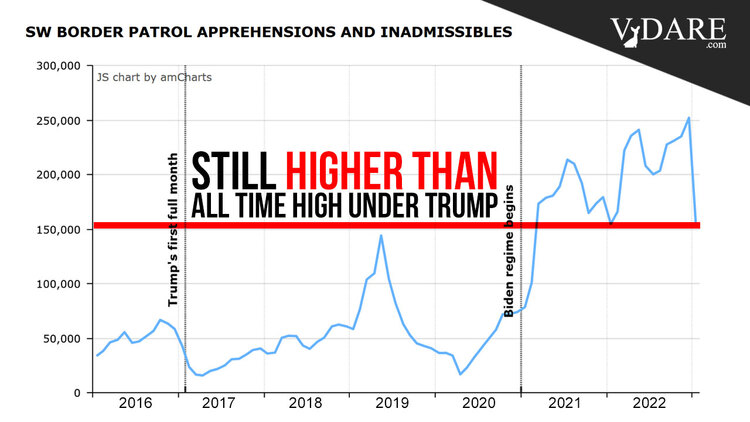Usually the CBP apparatchiks responsible for releasing the Border Crossing statistics wait until as late as possible, sometimes on the fourth Friday of a five-Friday month, or in December 2021, on the the third Friday of a month in which the fourth Friday was Christmas Eve. This time, they were out on Friday, February 10, and that may mean that the CBP apparatchiks think the numbers, especially the unusual dip at the end of this month's chart, make them look good.
They're wrong. These numbers—for the month of January, traditionally a slow month in illegal border crossings, because Mexicans celebrate Christmas, too—are only low if you compare them to previous Biden Rush months.
CIS's Andrew Arthur writes
On the afternoon of Friday, February 10, CBP released its latest statistics on the agency’s encounters of aliens at the Southwest border. They’re nothing to crow about: Border Patrol agents apprehended more than 128,000 illegal migrants in the slowest travel month of the year, while CBP officers at the ports of entry stopped nearly 28,000 additional inadmissible aliens. The Biden administration’s only doing better compared to its otherwise dismal track record. Here’s how we got here, and more importantly where we’re going.
The Border Numbers, in Context. In this context, CBP “encounters” are the sum of Border Patrol apprehensions at the Southwest border plus aliens deemed inadmissible at the ports of entry along that border. In total, the agency encountered more than 156,000 aliens at the U.S.-Mexico line in January.
As noted, more than 128,000 of those encounters were illegal migrants encountered by Border Patrol agents, while almost 28,000 others were would-be immigrants stopped by CBP officers at the ports.
Border Patrol hasn’t apprehended fewer than 148,000 migrants at the Southwest border since February 2021 — Biden’s first full month in office — when agents caught just fewer than 98,000 illegal entrants.
By that standard, the Biden administration did well last month. But only by that standard.
Between April 2006 (when agents nabbed just short of 161,000 illegal migrants) and February 2021, apprehensions exceeded 128,000 in just one month: May 2019, when agents stopped fewer than 133,000 aliens who had crossed the border illegally.
In other words, there were only 3.4 percent fewer apprehensions last month than in the worst month for apprehensions at the Southwest border in the 13-year period between May 2006 and May 2019.
Still, that’s better than apprehensions continuing the blistering pace they had been from September to December 2021, when they exceeded 200,000 per month.
To put those numbers into context — particularly that May 2019 Trump-era high — apprehension numbers were so daunting in FY 2019 that then DHS Secretary Kirstjen Nielsen declared a “border emergency”, stating in March of that year:
Today I report to the American people that we face a cascading crisis at our southern border. The system is in freefall. DHS is doing everything possible to respond to a growing humanitarian catastrophe while also securing our borders, but we have reached peak capacity and are now forced to pull from other missions to respond to the emergency.
If the system was in “freefall” in FY 2019 — a year when apprehensions at the Southwest border barely exceeded 851,500 — what word would an objective observer use to describe the situation today? In just the first four months of the current fiscal year, apprehensions have already exceeded 762,000, and “travel season” — the period in which illegal entries surge — has not yet begun.
CBP January Border Numbers Are Nothing to Crow About
Apprehensions top 128,000 in slowest travel month; Biden’s only doing better compared to how dreadful his performance had been, while the administration’s hiding the true scope of the disaster
By Andrew R. Arthur, February 13, 2023 [Emphasis added]
I should say that as well as the illegal immigrants who simply wade across or walk across, there's the parole program, in which exactly the same people will come in without being counted as illegal, because the Biden Administration will provide what Andrew Arthur calls "a pseudo-legal gloss" to their presence.
“New Border Enforcement Actions”. For the first two years of the Biden administration, providing “safe, orderly, and legal pathways” for aliens to access our legal system meant treating every illegal migrant as an “asylum seeker”, and releasing most of the ones who weren’t expelled under Title 42 into the United States.
The administration had months to come up with a plan to deal with the potential post-Title 42 migrant influx, but it wasn’t until January 5 that the White House produced what it termed its “New Border Enforcement Actions” in a fact sheet issued that day.
Of the different proposals in the January 5 fact sheet, two stand out: (1) An extension of a Venezuelan parole program that will now also apply to Nicaragua, Haiti, and Cuba, allowing 30,000 nationals of those countries to enter the United States per month — with work authorization — on parole for a two-year period, in lieu of entering illegally; and (2) access for would-be illegal migrants to the CBP One app, allowing them to schedule appointments for interviews with CBP officers at the ports of entry, again, instead of entering illegally.
The first proposal is likely an illegal use of DHS’s limited parole authority (it’s being challenged by a group of state plaintiffs in a case captioned Texas v. DHS), while the second won’t do anything to ameliorate the dangers migrants face on the perilous trek to the Southwest border — it will simply add a pseudo-legal gloss to illegal migration.
What that "pseudo-legal gloss" means is that Biden isn't fighting illegal immigrant smuggling, he's engaging in it.













